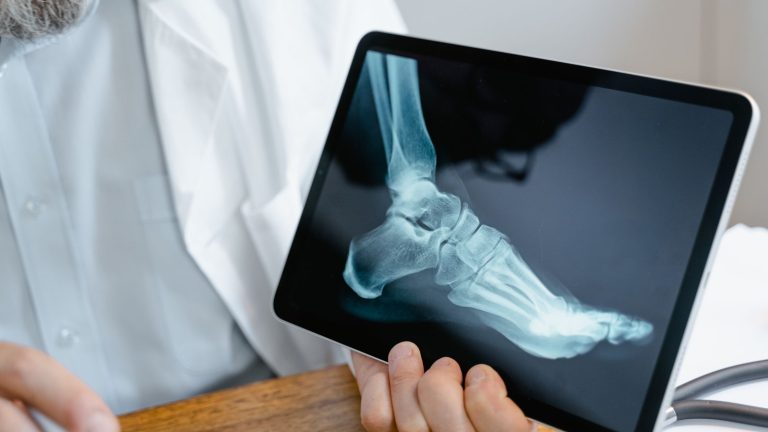FOOT AND ANKLE SURGERY
FOOT AND ANKLE SURGERY
Foot and ankle surgery is a sub-set of orthopedics and podiatry that deals with the treatment, diagnosis, and anticipation of syndromes of the foot and ankle. Foot and ankle specialists in the Department of Orthopedic Surgery use leading-edge science and technology to extravagance a wide series of musculoskeletal situations and to escape the use of needless medical tests and processes whenever probable. The methodology is broad and contains all features of the focus from basic science to clinical supervision. Difficulties of both children and adults are involved, as is trauma and chronic disease. The direct arrival of swelling in the area is due to internal bleeding. Most ankle injuries can be accomplished conventionally. Rest, ice, compression, and elevation (RICE) therapy are introduced as soon as possible next an acute sprain
CHRONIC ANKLE SPRAIN:
Ankle sprains that do not heal well result in instability of the ankle. The drawer test is one of the methods used to assess ankle instability. An optimistic drawer test determines extreme gesture in the anteroposterior direction at the ankle joint.
LATERAL ANKLE SPRAIN:
Lateral ankle tendon healing/renovation are a common surgical technique commenced in patients with chronic lateral ankle instability. To reinstate stability, the anterior talofibular tendon and the calcaneofibular tendons are stiffened by double breasting (overlapping the coatings) or by preceding their add-on on the fibula.
ACHILLES TENDON RUPTURE:
Acute Achilles tendon rupture happens just proximal to the site of its supplement in the calcaneus. When exaggerated patients are placed in the lying position, the loss of plantar flexion tone is apparent on comparison of both sides.
ANKLE FRACTURE:
Ankle fractures are common injuries nearby the ankle joint and happen when the malleoli are broken. Pretentious persons experience abrupt severe pain and swelling, shadowed by trouble and inability in posture weight on the injured foot. The swelling, bruising, and tenderness are best over the injured malleoli.
Open reduction and internal fixation (ORIF) is the most habitually used procedure to heal ankle fractures. Open reduction refers to an operative rearrangement of the fractured bones, and internal fixation denotes to the use of metal plates and/or screws to protect the bones in the exact position. Metal plates have been sighted in position on the back of the fibula and the posterior malleolus. These plates are used to protect the fractures.
COMMON TYPES OF FOOT & ANKLE SURGERY
BUNIONS:
Bunions are bony swellings that advance on the side of your foot and at the base of your big toe. They have the consequence of a disorder called hallux valgus, which bases your big toe joint to bend near the other toes and become malformed. If symptoms transmit over a long period, your toe may need to be surgically modified. This includes straighten out your big toe and metatarsals, a procedure called an osteotomy. Though this may make your joint firmer, it comfort the pain.
HAMMER’S TOES:
As well as bunions, hallux valgus can also origin your other toes to become scrambled or lastingly bent. This situation is known as hammer toes. Damages affected by hammer toes can be relieved by:
ARTHROPLASTY
Eliminating the misshapen joint between your toe bones (phalanges), which leaves the joint flexible?
ARTHRODESIS
Merging your phalanges together, which leaves your toe more constant but means you’ll only be able to wear flat shoes after the process.
Both procedures are done during day day and last about an hour. Your stitches will be detached about two to three weeks next surgery and you will require another bandage for two to six weeks after that. You should decide how much you can walk for the first three days.
METATARSAL SURGERY:
The joints in your forefoot can be injured by the tenderness of the lining of your joint (synovitis) in some forms of arthritis, for example, rheumatoid arthritis. These minor joints are called the metatarsophalangeal joints (MTPJs), and they can convert disrupted when injured by arthritis. The pain and uneasiness are sometimes defined as feeling like you’re walking on pebbles.
ANKLE ARTHRITIS:
Ankle arthritis is generally caused by osteoarthritis. This is where the cartilage wrapping the ends of your bones slowly roughens and becomes thin and the bone under thickens. It can also be affected by damage from other rheumatic conditions, for example, if you have rheumatoid arthritis, or if you’ve had a former injury to the area. This leads to pain, swelling and infrequent malformation of the joint. You may need surgery if your symptoms are severe.
MORTON’S NEUROMA:
Morton’s neuroma is an aching condition that implicates a nerve that supplies sensation to two adjacent toes. It most usually disturbs the nerve to your third and fourth toes. If your symptoms are wicked, surgery to eradicate the painful nerve can be effective. This can be done as a day case and you’ll need to dress a bandage for two weeks later.
PLANTAR FASCIITIS:
The plantar fascia is a hard band of fibrous tissue that starts at your heel bone and stretches diagonally the solitary of your foot to your toes. Plantar fasciitis is swelling at the site where the fascia attaches to your heel. Very rarely, bad cases may need surgery to relief the plantar fascia from the heel bone. This technique is frequently done as a day case and it takes less than an hour. You’ll only want to dress a bandage after the operation.






